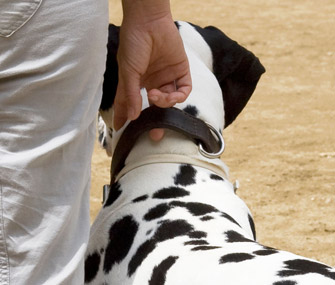How Can I Teach My Dog To Be Led by the Collar?
Published on October 16, 2012

Q. When I try to lead my dog by her collar, she pulls back and sits down. How can I get her to follow me?
A. It can be terrifying for a dog to have someone grab her collar and start pulling her along. She may not understand what’s being asked of her, and her response is to pull in the opposite direction or go into a sit. Dogs who haven’t been taught to be led in this manner may also bite, especially if people don’t notice the warning signs, like the whites of their eyes showing or a tucked tail, which shows that they are anxious.
There are some simple strategies for getting a dog comfortable with being led by the collar. While hand targeting is a much easier way to move a dog without having to physically hold her, I want the dogs I work with to be prepared for the collar pull in the event that it happens with another family member, at a doggy day care or veterinary office, or in any other situation.
How to Avoid Catastrophe — Or a Bite
It is essential that you teach your puppy to be comfortable with assorted types of touching and moving. During my last puppy class, one pet owner confessed that he was relieved we were practicing this with his new Heeler puppy. He had tried to lead a previous dog by the collar and ended up with a serious bite on his arm. Most dogs won’t actually bite when they’re led by the collar but will just be nervous or uncomfortable and may pull away from you or hesitantly follow. But with just a few training steps, you can teach your dog to relax when led by her collar.
Start by teaching your dog that it's OK for you to reach for her collar. A dog who is unaccustomed to having people reach for her collar may duck away when this happens. Start by reaching out toward your dog but not touching her neck as you mark her staying relaxed with a “good.” Treat immediately out of your other hand. If your dog is relaxed, you can touch the collar and reward her for staying calm.
Once your dog is willing to let you touch her collar, teach her to follow a collar pull using a food lure. Do a small pull on the collar and immediately present a treat in front of her nose, just out of reach. If she makes any attempt to walk toward the treat, mark and reward with the treat. As your dog becomes more comfortable with this, move the food lure in front of her and pull lightly on her collar. Keep in mind that you will only need a slight and gentle collar pull to get your dog moving. You should never pull sharply on the collar, as this can injure your dog's neck or trachea (the main airway for breathing).
As soon as she is moving, stop pulling; you should be using the collar to guide the dog in the right direction, not pull her along. If she refuses to move forward, reward small movements, such as edging her nose out toward the food lure.
Phase Out the Food Lure
Once your dog is moving readily when you pull on her collar and walking after the food lure, remove the food lure and hide the hand with the treat in it behind your back. Do a small pull on your dog’s collar, and if she makes any slight move in response to the pressure, immediately reward with a treat. If she doesn’t move right away, wait a second and then pull out the hidden treat and present it in front of your dog to encourage movement. Once you repeat the collar pull and reward, your dog should readily start walking in the direction of the collar pull to get her treat.
You can also practice turning while you’re walking by turning your body and walking forward in the direction you want to go. While most dogs will naturally turn with you, you may need to use a food lure to direct some dogs in the proper direction. For dogs who need a lure to turn, fade this over time by rewarding them for turning even slightly in the direction you are gently pulling toward and pulling out the food lure after a couple of seconds if your dog doesn’t follow.
You can start to integrate other rewards to wean your dog off treats, such as praise, petting or a toy. Over time, being led by the collar should become like second nature to your dog and she should readily follow your lead.





